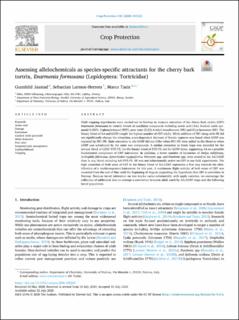| dc.contributor.author | Jaastad, Gunnhild | |
| dc.contributor.author | Larsson-Herrera, Sebastian | |
| dc.contributor.author | Tasin, Marco | |
| dc.date.accessioned | 2020-10-13T14:52:45Z | |
| dc.date.available | 2020-10-13T14:52:45Z | |
| dc.date.created | 2020-09-23T15:12:03Z | |
| dc.date.issued | 2020-07-22 | |
| dc.identifier.citation | Crop Protection. 2020, 138 1-6. | en_US |
| dc.identifier.issn | 0261-2194 | |
| dc.identifier.uri | https://hdl.handle.net/11250/2682536 | |
| dc.description.abstract | Field trapping experiments were carried out in Norway to measure attraction of the cherry bark tortrix (CBT) Enarmonia formosana to volatile blends of candidate compounds including acetic acid (AA), linalool oxide pyranoid (LOXP), 2-phenylethanol (PET), pear ester (E,Z)2,4-ethyl decadienoate (PE) and (E)-β-farnesene (BF). The binary blend of AA and LOXP caught the highest number of CBT adults. While addition of PET along with PE did not significantly change the attraction, a sex-dependent decrease of female captures was found when LOXP was replaced by PET/PE. Male attraction to AA/LOXP did not differ when PET/PE were added to the blend or when LOXP was substituted by the same two compounds. A similar attraction to blank traps was recorded for the ternary blend of LOXP/PET/PE, for the binary blend of PET/PE and for LOXP alone, supporting AA as a possible fundamental component of CBT kairomone. In addition, a lower number of bycatches of Hedya nubiferana, Anthophila fabriciana, Synanthedon myopaeformis, Pammene spp. and Pandemis spp. were scored in the AA/LOXP than in any blend including AA/PET/PE. BF was not behaviourally active on CBT in our field experiments. The high attraction of both sexes of CBT to the binary blend of AA/LOXP represents a first step towards the identification of a multicomponent kairomone for this pest. A continuous flight activity of both sexes of CBT was recorded from the end of May until the beginning of August, supporting the hypothesis that CBT is univoltine in Norway. Because larval infestation on tree trunks varies substantially with apple varieties, we encourage the collection of additional data to attempt a correlation between adult catch by AA/LOXP traps and the following larval population. | en_US |
| dc.language.iso | eng | en_US |
| dc.publisher | Elsevier Ltd | en_US |
| dc.rights | Navngivelse 4.0 Internasjonal | * |
| dc.rights.uri | http://creativecommons.org/licenses/by/4.0/deed.no | * |
| dc.title | Assessing allelochemicals as species-specific attractants for the cherry bark tortrix, Enarmonia formosana (Lepidoptera: Tortricidae) | en_US |
| dc.type | Peer reviewed | en_US |
| dc.type | Journal article | en_US |
| dc.description.version | publishedVersion | en_US |
| dc.rights.holder | © 2020 The Authors | en_US |
| dc.source.pagenumber | 1-6 | en_US |
| dc.source.volume | 138 | en_US |
| dc.source.journal | Crop Protection | en_US |
| dc.identifier.doi | 10.1016/j.cropro.2020.105323 | |
| dc.identifier.cristin | 1832651 | |
| cristin.ispublished | true | |
| cristin.fulltext | original | |
| cristin.qualitycode | 1 | |

